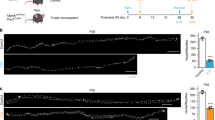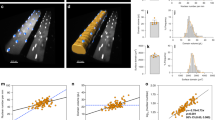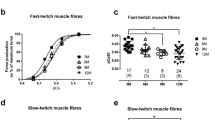Summary
The factors that determine ultimate muscle size have been studied using a “model” that involves two strains of mice, which had been especially bred for “largeness” (QL) and for “smallness” (QS). The difference in muscle size was not found to be due to a difference in fibre size, but due to a difference in fibre number. The muscles from the “QL” mice contained about 30% more fibres.
The reason for this increased fibre number was investigated. During early development, the fusion of mononucleated presumptive myoblasts to form multinucleated myotubes took place at the same time in both “QL” and “OS” mice, as indicated by the appearance and increase in activity of ATP: creatine phosphotransferase. At this stage fibre (and cell) number and size could be determined by measuring nuclear number and protein/DNA ratio respectively. No difference in fibre (and cell) size could be found in mice at 5 days before birth, newly born, or at 20 days of age. At these ages it was found that the muscles from the “QL” mice contained a greater number of nuclei (muscle cells). The amount of RNA/nucleus was used as an index of protein synthetic rate, and no difference could be found between the large mice and the small mice.
It was concluded that, in the case of the “QL” mice, the increased fibre number was not brought about by: (i) a delay in time of fusion of presumptive myoblasts; (ii) a smaller number of myoblasts fusing to form myotubes; or (iii) extensive fibre formation after fusion. Differences in fibre number, and hence muscle size, must therefore, presumably be caused by initial differences in the rate of proliferation of myoblasts before fusion.
Similar content being viewed by others
References
Bailey JL (1962) In Techniques in Protein Chemistry. Elsevier Publishing Co, Amsterdam London New York, p 294
Bonting SL, Jones M (1957) Determination of microgram quantities of deoxyribonucleic acid and protein in tissues grown in vitro. Arch Biochem Biophys 66:340–353
Burleigh IG (1974) On the cellular regulation of growth and development in skeletal muscle. Biol Rev 49:267–320
Burleigh IG (1977) Observations on the number of nuclei within the fibres of some red and white muscles. J Cell Sci 23:269–284
Ceriotti G (1955) Determination of nucleic acids in animal tissues. J Biol Chem 214:59–70
Cheek DB, Holt AB, Hill DE, Talbert JL (1971) Skeletal muscle cell mass and growth: The concept of the deoxyribonucleic acid unit. Pediat Res 5:312–328
Dawson DM, Goodfriend TL, Kaplan NO (1964) Lactic dehydrogenases: Function of the two types. Sci 143:929–933
Enesco M (1957) Increase in cell number and size and in extracellular space during post-natal growth of several organs in the albino rat (cited by Enesco and Puddy 1964). Ph D Thesis McGill University, Montreal, Canada
Enesco M, Leblond CP (1962) Increase in cell number as a factor in the growth of the organs and tissues of the young male rat. J Embryol Exp Morphol 10:530–562
Enesco M, Puddy D (1964) Increase in the number of nuclei and weight in skeletal muscle of rats of various ages. Am J Anat 114:235–244
Fanburg BL, Drachman DB, Moll D, Roth SI (1968) Calcium transport in isolated sarcoplasmic reticulum during muscle maturation. Nature 218:962–964
Fleck A, Begg D (1965) The estimation of ribonucleic acid using ultra-violet absorption measurements. Biochim Biophys Acta 108:333–339
Fletcher L, Rider CC, Taylor CB, Adamson ED, Luke BM, Graham CF (1978) Enolase isoenzymes as markers in differentiation in tetrocarcinoma cells and normal tissues of mouse. Dev Biol 65:462–475
Goldspink G (1974) Development of muscle, Chap 3. In: Goldspink G (ed) Differentiation and Growth of Cells in Vertebrate Tissues. Chapman and Hall, London
Gordon EE, Kowalski K, Fritts M (1966) Muscle proteins and DNA in rat quadriceps during growth. Am J Physiol 210:1033–1040
Gornall AG, Bardawill CJ, David MM (1949) Determination of serum proteins by means of the biuret reaction. J Biol Chem 177:751–766
Holtzer H, Rubenstein N, Fellini S, Yeou G, Chi J, Birnbaum J, Okayama M (1975) Lineages, quantal cell cycles and the generation of cell diversity. Quart Rev Biophys 8:523–557
Layman DK, Hegarty PVJ, Swan PB (1980) Comparison of morphological and biochemical parameters of growth in rat skeletal muscles. J Anat 130:159–171
Luff AR, Goldspink G (1967) Large and small muscles. Life Sci 6:1821–1826
Luff AR, Goldspink G (1970) Total number of fibres in muscles of several strains of mice. J Anim Sci 30:891–893
Martin R, White J, Herbein J, Ezekwe MO (1979) Muscle and adipose cell development in mice selected for postweaning growth rate. Growth 43:167–173
Maxwell CL, Faulkner JA, Lieberman DA (1973) Histochemical manifestations of age and endurance training in skeletal muscle fibres. Am J Physiol 224:356–361
McCance RA (1962) Food, growth and time. Lancet (2):621–626
McCarthy JC (1967) The effects of interbreeding on the components of litter size in mice. Genet Res 10:73–80
Millward DJ, Garlick PJ, James WPT, Nnanyelugo DO, Ryatt JS (1973) Relationship between protein synthesis and RNA content in skeletal muscle. Nature 241:204–205
Mirsky AE, Ris H (1949) Variable and constant components of chromosomes. Nature 163:666–667
Morris GE (1978) The use of creatine kinase activity as an index of skeletal muscle differentiation. Biochem Soc Trans 6:509–511
Moss FP (1968) The relationship between the dimensions of the fibres and number of nuclei during normal growth of skeletal muscle in the domestic fowl. Am J Anat 122:555–564
Munro HN, Fleck A (1969) Determination of nucleic acids. Methods of biochemical analysis 14:113–176
Nielsen L, Ludvigsen B (1963) Improved method for the determination of creatine kinase. J Lab Clin Med 62:159–168
Obinata T, Yamamoto M, Maruyama K (1967) Morphological and biochemical studies on myofibrillar formation in developing chick embryo. Sci Papers Coll Gen Educat Univ Tokyo 17:95–120
Oliver IT (1955) A spectrophotometric method for the determination of creatine phosphokinase and myokinase. Biochem J 61:116–122
Ontell M, Dunn RF (1978) Neonatal muscle growth: A quantitative study. Am J Anat 152:539–559
Rayne J, Crawford GNC (1975) Increase in fibre numbers of the rat pterygoid muscles during postnatal growth. J Anat 119:347–357
Reporter MC, Konigsberg IR, Strehler BL (1963) Kinetics of accumulation of creatine phosphokinase activity in developing embryonic skeletal muscle in vivo and in monolayer culture. Exp Cell Res 30:410–417
Robinson DW, Bradford GE (1969) Cellular response to selection for rapid growth in mice. Growth 33:221–229
Rowe RWD (1967) The post-natal growth and development of striated muscle fibres in normal and dystrophic mice. Ph D Thesis, University of Hull
Rowe RWD, Goldspink G (1969) Muscle fibre growth in five difference mucles in both sexes of mice. J Anat 104:519–530
Shaninberg A, Yagil G, Yaffe D (1971) Alterations of enzymatic activities during muscle differentiation in vitro. Dev Biol 25:1–29
Stein JM, Padykula HA (1962) Histochemical classification of individual skeletal muscle fibres of the rat. Am J Anat 110:103–124
Totsuka T, Watanabe K, Kiyono S (1981) Maturational defects of muscle fibers in the muscular dystrophic mice. Cong Anom 21:253–259
Trayer IP, Perry SV (1966) The myosin of developing skeletal muscle. Biochem Z 345:87–100
Wannemacher RW, Banks WL, Wunner WH (1965) Use of a single tissue extract to determine cellular protein and nucleic acid concentrations and rate of amino acid incorporation. Anal Biochem 11:320–326
Widdowson EM (1970) Harmony of growth. Lancet (1):901–905
Winick M, Noble A (1966) Cellular response in rats during malnutrition at various ages. J Nutr 89:300–306
Young VW (1970) The role of skeletal and cardiac muscle in the regulation of protein metabolism. In: Munro HN (ed) Mammalian protein metabolism, Vol 4. Academic Press, New York London
Author information
Authors and Affiliations
Rights and permissions
About this article
Cite this article
Penney, R.K., Prentis, P.F., Marshall, P.A. et al. Differentiation of muscle and the determination of ultimate tissue size. Cell Tissue Res. 228, 375–388 (1983). https://doi.org/10.1007/BF00204886
Accepted:
Issue Date:
DOI: https://doi.org/10.1007/BF00204886




